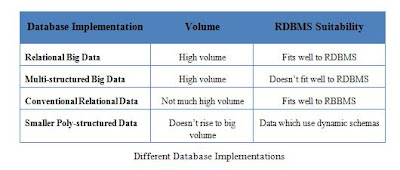Big Data Analysis
We can simply describe the word ‘Big Data’ as the datasets that are difficult to handle and work with. We can reduce the depth of the meaning by categorizing it according to its properties. Mainly big data can be reduced to two dimensions as Bigness and Structure of the data. This can be further categorized as follows. [reference]
According
to the above structure in our discussion on Big Data on RDMS we can categorize
different aspects of this topic according to the properties of data set. We can
simplify different uses of database implementation as follows,
Relational Databases on Big Data
When scaling relational database system to a
relational big data system the system designer needs to address many aspects
since traditional relational database systems are built to run on a single
machine and tries to accomplish all queries that it receives. When scaling these systems sometimes the read
and write throughput of the system becomes too much to handle for the system.
This is mainly because relational database systems were not designed for
distributed or shared systems and the additional overheads incur during these
processed would trouble the normal operation of the system. The scaling
techniques used on such a system would cost significant complexity and loss of
fault tolerance.
Relational
Data Model- Handle high incoming request load in system
In a relational database system we can use batch write the
incoming requests to increase the performance of the system. But if consider a system which handle 'Big Data' scale requests this much scaled
system cannot be addressed using a batch writes and reading.
- Creating database copies
When scaling up the database different copies of the database
need to be maintaining to increase the availability of the data. If not when
some system or network failure happens the database will be inconsistent or
unavailable. Not only this is a manual and multi-step process in relational
databases but also it creates more problems when new nodes are added to the
system. These kind of bottle-necks are not suitable on system which handle huge amount of data since in-case if we need to add new nodes to increase the performance it must be
less trouble and cost effective.
- Complexity when changing the database scheme
In relational database systems when we need to change the
database or one of its tables this schema migration need to handle manually on
each and every shared node and updating a schema can be more time consuming and
painful. So if we implement
our system on Relational databases it will be more trouble during operations
and maintaining the system.
- Fault tolerance
In
a parallel database system there is a high probability about one node might
going down due to disk filling up, damaging or due to breakdown of a node. Even
when the amount of system share increases the system will be less
fault-tolerant.
Multi-structured Model on Big Data
One such example for this kind of database
implementation would be a system which stores log files. These systems can be
highly scalable, analytical and cost effective. When implementing these use
cases NoSQL comes to action in most of the cases because of its properties
which will be discussed in latter part of this report. As rapid evolution of
Web service technologies which grow on exponential manner challenged the traditional
theories and approaches of database systems. Due to this reason most of the
researches done on multi-structured big data and its data management were
conducted by large web companies like Google, Amazon, Facebook etc. since they
were the initial party who faced these requirements on their systems before
most of the industry driven applications adopt the technology.
No-SQL
Data Model
- Handle high incoming request load in system
The database systems designed for big data conceptually address this
issue and it will be hidden form the user and the application.
- Creating database copies
Maintaining different copies of databases manually become complex task
for the system itself and for the designers of that system. In database systems
designed for big data parallelism of the system will be hidden form the
application and the system will be more user friendly to the system designers.
- Complexity when changing the database scheme
No-SQL database systems which usually handle big data basses
will usually keep and maintain some amount of metadata and row data about the
system. So during a change in the system they use this metadata knowledge
during modification rather than just aggregating from the data itself. So this
kind of problems will not be occurring on the system.
- Fault tolerance

